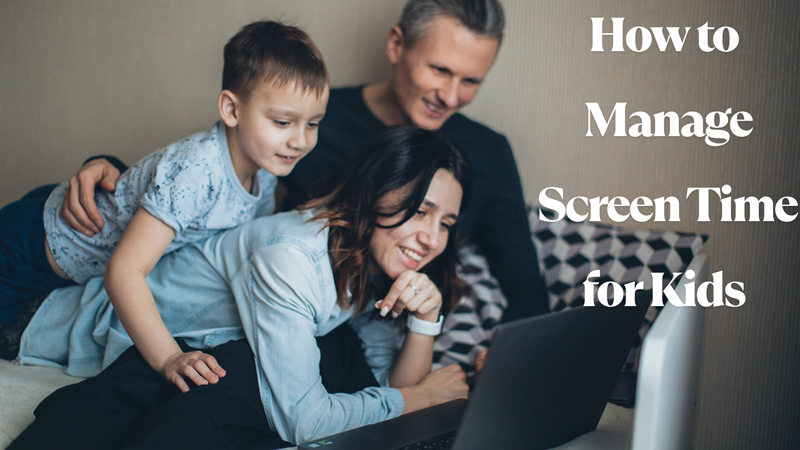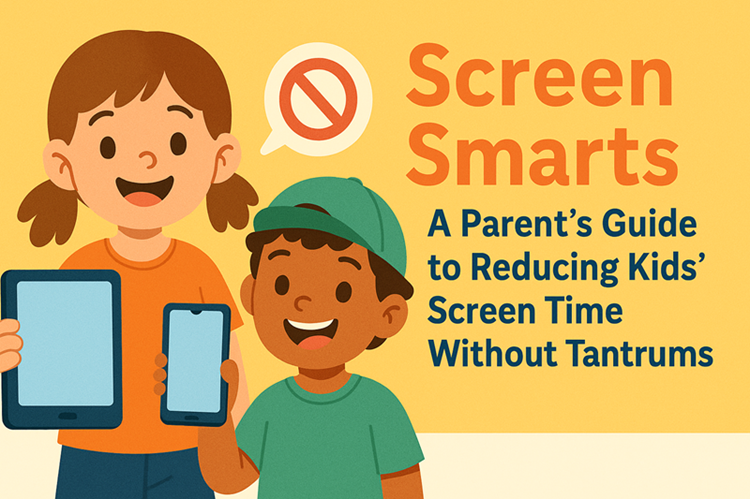How To Reduce Screen Time For Kids – Personal Experience
I remember when my son was little and screens seemed like just another toy—until suddenly, they were everywhere. I’d catch my son glued to a tablet, texting friends, and even our family dinners started to get interrupted by the buzz of a new notification. At first, I didn’t think much of it. After all, technology is part of learning and staying connected these days. But over time, I noticed how too much screen time left my kids restless at bedtime and less interested in playing outside. That’s when I realized that, while screens aren’t always the enemy, finding a balance is something every parent has to figure out for themselves.
As a parent myself, I’ve often found myself wondering: How can I help my kids cut back on screen time without turning every day into a tug-of-war or feeling guilty about every little exception? It’s not always easy, but over the years, I’ve learned a few things about what works—and what doesn’t. In this guide, I want to share tips of how to reduce screen time for kids, not just the risks of too much screen use, but also some practical, positive steps we’ve taken at home to bring back a little more balance and a lot more peace.
Why Too Much Screen Time Hurts Kids
Physical Health Risks
- Less Movement = More Health Problems: Sitting still with screens for hours can lead to weight gain, poor posture, and even higher chances of lifestyle-related diseases like diabetes.
- Eye Strain and Discomfort: Staring at screens for long stretches can hurt your child’s eyes, causing dry eyes, blurry vision, or headaches.
- Sleep Struggles: The blue light from screens messes with the body’s natural sleep signals. Kids who use screens before bed often sleep poorly.
Brain and Developmental Concerns
- Delayed Development in Toddlers: Kids under 5 who have more than 4 hours of daily screen time may show slower progress in problem-solving, speaking, and coordination.
- Shorter Attention Spans: Constant screen-switching can make it hard for kids to focus, pay attention, or complete tasks in school.
- Fewer Real Conversations: Face-to-face chats help kids learn language and social skills. Screens can take away from those vital human interactions.
Emotional and Mental Health Effects
- Increased Anxiety: High screen use is linked to more anxiety, trouble controlling emotions, and even symptoms similar to ADHD.
- Fewer Family Bonds: Screens replace quality time. When kids are glued to devices, family interactions decrease.
Why Reducing Screen Time is So Important
Cutting down screen time isn’t about banning fun or being the “bad guy.” It’s about helping your child thrive—physically, emotionally, and mentally. Reducing screens makes room for:
- Healthier bodies,
- Better sleep,
- Stronger family relationships,
- Smarter brains, and
- More creativity and confidence.

How I Reduced Screen Time for My Kids: Real-Life Tips for Parents
If you’re anything like me, you’ve probably looked up from your phone or laptop and realized your kids have been glued to their screens for hours. I used to feel so guilty about this, especially during the pandemic when screens became a lifeline for school and entertainment. But over time, I’ve found a few strategies that actually work for our family—and I want to share what’s helped us.
1. Setting Realistic Boundaries (and Sticking to Them)
At first, I tried to go cold turkey—no screens during the week! That lasted about two days before the meltdowns started (from both the kids and me, honestly). Now, we have simple rules: after homework and chores are done, they get one hour of screen time. I set a timer on my phone, and when it goes off, we all put our devices away together. It’s not perfect, but it’s manageable.
2. Leading by Example
This was the hardest part for me. I realized I couldn’t expect my kids to cut down on screens if I was scrolling Instagram all evening. Now, I try to put my phone away during family time. Sometimes, my kids call me out (“Mom, you said no screens!”), and I have to laugh and admit they’re right.
3. Swapping Screens for Activities
One Saturday, I suggested we bake cookies instead of watching cartoons. The kitchen was a mess, but we had so much fun. Now, we try to do one “screen-free” activity each weekend—whether it’s a board game, a walk, or just drawing together. The kids even come up with their own ideas now!
4. Talking About Screens, Not Just Banning Them
I found that explaining “why” we limit screens helped a lot. We talk about how too much screen time can make us feel tired or cranky, and how it’s important to rest our eyes and minds. My youngest even started reminding me when it’s time for a break!
5. Being Flexible and Forgiving
Some days, the rules go out the window—like when someone’s sick or it’s pouring rain. I’ve learned not to beat myself up about it. The goal isn’t perfection; it’s balance.
Kids Watch What You Do: Be a Role Model
Your kids are learning from you—even when you don’t realize it. If you’re always checking your phone, they will too.
- Put Devices Away: No phones at meals or during storytime.
- Join in Screen-Free Fun: Your involvement makes offline activities more exciting.
- Talk About Balance: Be honest about your own screen struggles and why digital breaks help everyone.
Small Daily Changes = Big Wins
You don’t need to throw all the gadgets out the window. Just a few tweaks to daily life can make a big impact:
- Screen-Free Dinners: Encourage talk-time instead of tablet-time.
- No Screens in Bedrooms: Sleep gets better when devices stay out.
- Walk, Don’t Drive: When possible, walk to school or shops for built-in exercise and connection time.
- Plan Unplugged Hours: Choose an hour before bedtime or after school to unplug together.
What If It’s Hard?
Kids Push Back?
- Stay calm. Change is tough.
- Validate their feelings: “I know you love that show, and it’s fun.”
- Offer appealing alternatives like baking, crafts, or bike rides.
You’re Too Busy?
- Prepare screen-free independent play ideas: coloring kits, LEGOs, puzzles.
- Rotate toys weekly to keep the excitement alive.
- Use audio stories or music playlists for downtime.
The Role of Schools and Communities
- School Support: Advocate for media literacy lessons and daily outdoor breaks.
- After-School Programs: Sign up for sports, drama, or nature clubs.
- Community Events: Attend or organize unplugged weekends, book swaps, or screen-free playdates.
When Screen Time is Actually Good
Not all screen time is bad. It depends on what, how much, and why.
Good screen time includes:
- Educational games or apps,
- Story videos or nature documentaries,
- Video calls with family or friends.
Just be sure to balance it with real-life interaction and movement.
Quick Parent Checklist for Healthier Screen Habits
✔ Talk about screen use and set shared goals
✔ Create screen-free zones and schedules
✔ Plan fun, non-digital activities
✔ Use parental controls and timers
✔ Set a good example with your own habits
✔ Gradually reduce screen time, not all at once
✔ Replace screen time with rewarding alternatives
✔ Stay consistent and patient—it’s a process
FAQ: How to reduce screen time for kids
Q1: How much screen time is okay for kids?
A: The American Academy of Pediatrics recommends:
- Under 2 years: Avoid screens except video chats.
- 2–5 years: No more than 1 hour/day of high-quality content.
- 6+ years: Set consistent limits and ensure screen use doesn’t interfere with sleep, play, or family time.
Q2: What if my child uses screens for school?
A: Educational screen use is okay! Balance it with movement breaks and off-screen creative activities.
Q3: My child throws tantrums when I take the tablet away. What should I do?
A: Stay calm, validate their emotions, and stay firm with limits. Offer fun offline options and reward good behavior.
Q4: Is all screen time bad?
A: Not at all! Educational content, family movie time, and creative apps can be positive. It’s about balance and supervision.
Q5: How can I get my teen to reduce screen time?
A: Involve them in decision-making. Discuss health, sleep, and goals. Suggest digital detox hours and model balance yourself.
Final Thoughts
Every family is different, and what works for us might not work for you. But if you’re struggling to reduce screen time, you’re not alone. Start small, be patient with yourself and your kids, and celebrate the little victories. If you have any tips or stories, I’d love to hear them in the comments!
Start small today—your kids’ minds, bodies, and hearts will thank you tomorrow.
Read about Monsoon and School Reopening Tips For Parents, Back To School Tips After Summer Break and Foods That Might Be Harming Your Kids Brain Health
Read more about Kids Health and Parenting Tips.

Hi, I’m Prashant Jain — a curious soul, storyteller, and content creator at heart.I’ve always been drawn to the world of entertainment, travel, sports, health & lifestyle — not just as a writer, but as someone who genuinely lives these experiences. Whether I’m binge-watching the latest OTT series, exploring offbeat spiritual destinations in India, or diving deep into wellness routines and cricket match insights, I love sharing what I discover with like-minded readers.
PopNewsBlend is my way of blending personal journeys with meaningful stories — ones that inform, inspire, and keep you ahead of the curve. Everything I write comes from real observations, hands-on experiences, and a deep passion for understanding the world around us.
Discover more from Popnewsblend
Subscribe to get the latest posts sent to your email.








Pingback: 10 Brain Boosting Foods to Pack in Your Child Lunchbox
Pingback: 10 Gentle Parenting Secrets to Raise Kind, Respectful, and Well-Behaved Kids
Pingback: Kids Obesity: Causes, Health Risks, and How Parents Can Take Action
Pingback: Common Diseases in Kids During Monsoon: Symptoms, Prevention & Parent Tips
Pingback: How to Prepare Your Child for the Future: A Parent’s Complete Guide (2025)
Pingback: Raising Creative Kids : Why Boredom Is the Secret Ingredient
Pingback: How Excessive Cartoons Watching Affects Children’s Mind and Behavior